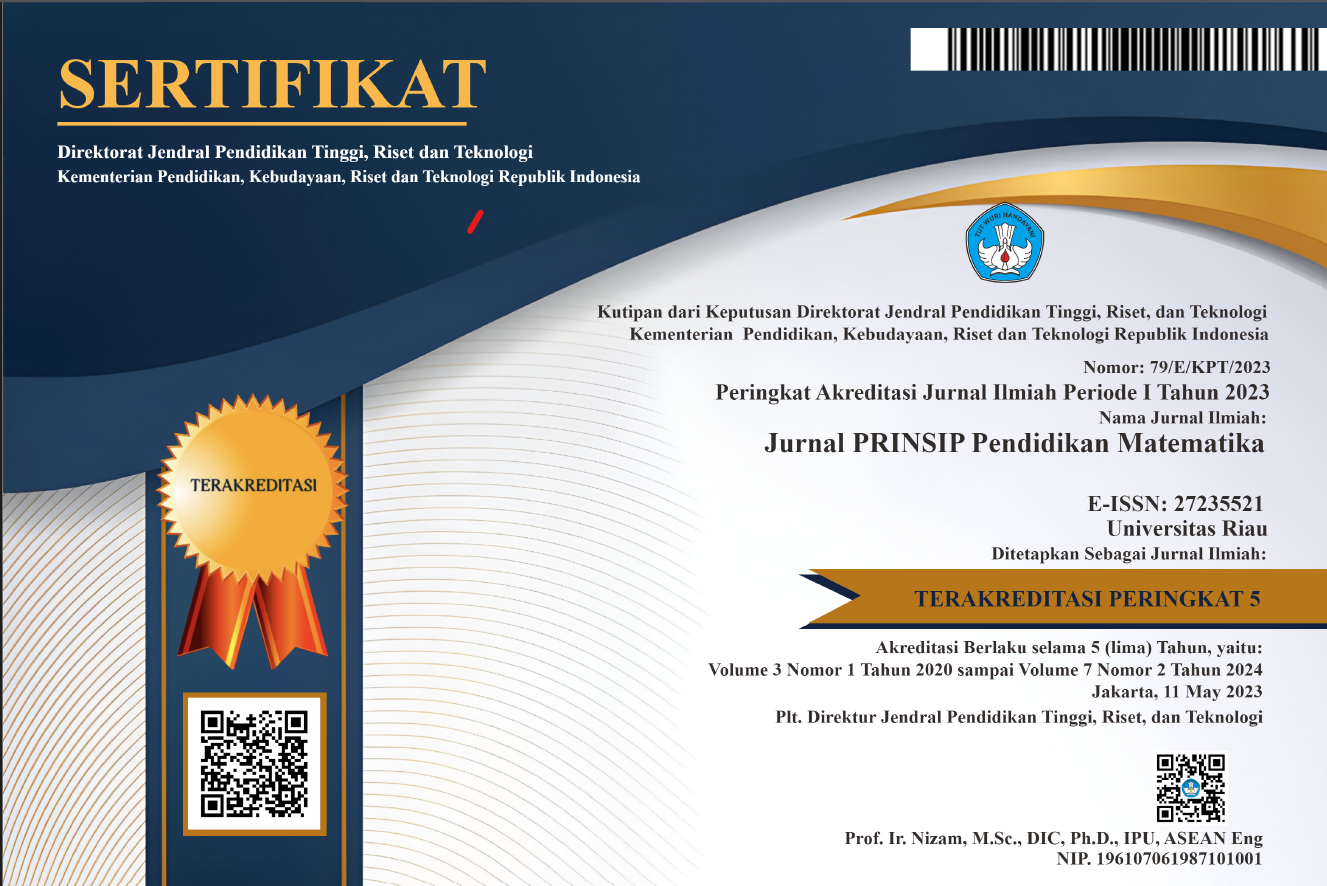STUDENTS’ MATHEMATICAL CONNECTION ABILITY IN TERMS OF SELF-CONFIDENCE
Abstrak
The connection was needed to solve mathematics problems. In connecting some concepts existing in mathematics to other fields of science, student self-confidence was required to solve the encountered problems. It was qualitative research, and this research aimed at knowing and describing students’ mathematical connection ability derived from their self-confidence in quadrilateral and triangle materials. The subjects of this research were the seventh-grade students at Junior High School of Juara Pekanbaru. The purposive sampling technique was used in this research. The instruments used in this research were the self-confidence questionnaire, mathematical connection ability test question, and interview guideline. All data were analyzed in three steps—data reduction, data display, and concluding. The research findings and data analyses showed that students’ self-confidence at Junior High School of Juara Pekanbaru differed. Overall, student mathematical connection ability was in enough category with 71.7%. Students with high self-confidence owned very good mathematical connection ability category, students with moderate self-confidence owned enough mathematical connection ability category, and students with low self-confidence owned very poor mathematical connection ability category.
##plugins.generic.usageStats.downloads##
Referensi
Ahmatika, D. (2016). Peningkatan kemampuan self confidence siswa melalui Resources-Based Learning (RPL) dengan pendekatan scientific. Seminar Nasional Matematika Dan Pendidikan Matematika.
Andayani, M., & MZ, Z. A. (2019). Membangun Self-Confidence siswa melalui pembelajaran matematika. Desimal: Jurnal Matematika, 2(2), 147–153. https://doi.org/https://doi.org/10.24042/djm.v2i2.4279
Fitriani, N. (2015). Hubungan antara kemampuan pemecahan masalah matematis dengan self confidence siswa SMP yang menggunakan pendekatan pendidikan matematika realistik. Euclid, 2(2).
Hamdani, M. F., & Nurdin, E. (2020). Kemampuan koneksi matematis berdasarkan minat belajar siswa. Juring (Journal for Research in Mathematics Learning), 3(3), 275–282. https://doi.org/http://dx.doi.org/10.24014/juring.v3i3.10346
Hartati, S., Abdullah, I., & Haji, S. (2017). Pengaruh kemampuan pemahaman konsep, kemampuan komunikasi dan koneksi terhadap kemampuan pemecahan masalah. MUST: Journal of Mathematics Education, Science and Technology, 2(1), 43–72. https://doi.org/10.30651/must.v2i1.403
Hendriana, H., Rohaeti, E. E., & Sumarmo, U. (2017). Hard skills dan soft skills matematik siswa. PT Refika Aditama.
Hodiyanto. (2017). Hubungan kemampuan pemecahan masalah matematis dan kemampuan koneksi matematis dengan prestasi belajar mahasiswa. Jurnal Pendidikan Informatika Dan Sains, 6(2), 208–218. https://doi.org/10.31571/saintek.v6i2.645
Hulukati, W. (2016). Pengembangan diri siswa sma. Ideas Publishing.
Johar, R. (2012). Domain PISA untuk literasi matematika. Jurnal Peluang, 1(1), 30–41.
Lestari, K. E., & Yudhanegara, M. R. (2015). Metode penelitian matematika. Reflika Aditama.
Miles, M. B., & Huberman, A. M. (1994). Qualitative data analysis (Second Ed). Sage Publication.
MZ, Z. A., & Risnawati. (2015). Psikologi pembelajaran matematika. Aswaja Pressindo.
NCTM. (2000). Principles and standards for school mathematics.
Nurafni, A., & Pujiastuti, H. (2019). Analisis kemampuan koneksi matematis ditinjau dari self confidence siswa: Studi kasus di SMKN 4 Pandeglang. ANARGYA: Jurnal Ilmiah Pendidikan Matematika, 2(1), 27–33. https://doi.org/https://doi.org/10.24176/anargya.v2i1.3013
OECD. (2019). PISA results 2018: combined executive summaries.
Pitriyani, P., Fitrianna, A. Y., Malinda, P., & Hajar, M. S. (2018). Analisis kemampuan koneksi matematis siswa mts ditinjau dari self confidence. JPPM (Jurnal Penelitian Dan Pembelajaran Matematika), 11(1), 105–115. https://doi.org/http://dx.doi.org/10.30870/jppm.v11i1.2989
Puspendik Kemendikbud. (2019). Laporan hasil ujian nasional. Kementrian Pendidikan Dan Kebudayaan.
Rosdianti, I., Alfiyah, N. F., & Zanthy, L. S. (2019). Analisis Kemampuan Koneksi Matematik dan Self Confidence Siswa SMP melalui Model Pembelajaran Think Pair Share. Desimal: Jurnal Matematika, 2(3), 289–295.
Siregar, H. M. (2019). Analisis Kesalahan Siswa dalam Menyelesaikan Soal Tes Kemampuan Berpikir Kreatif Matematis Materi Lingkaran. AKSIOMA: Jurnal Program Studi Pendidikan Matematika, 8(3), 497–507. https://doi.org/10.24127/ajpm.v8i3.2379
Solfitri, T., & Siregar, H. M. (2021). Developing integration techniques module to improve mathematical creative thinking ability in Integral Calculus. Jurnal PAJAR (Pendidikan Dan Pengajaran), 5(2), 296–305. https://doi.org/http://dx.doi.org/10.33578/pjr.v5i2.8221
Suhandri, Nufus, H., & Nurdin, E. (2017). Profil kemampuan koneksi matematis mahasiswa dalam menyelesaikan masalah matematika berdasarkan level kemampuan akademik. Jurnal Analisa, 3(2), 115–129. https://doi.org/10.15575/j.v3i2.1919
Surya, E., Sabandar, J., Kusumah, Y. S., & Darhim. (2013). Improving of Junior High School Visual Thinking Representation Ability in Mathematical Problem Solving by CTL. IndoMS JME, 4(1), 113–126.
Walle, J. A. Van de. (2008). Matematika sekolah dasar dan menengah. Erlangga.
Wardhani, S., & Rumiati. (2011). Instrumen penilaian hasil belajar matematika SMP : belajar dari PISA dan TIMSS. In Yogyakarta: PPPPTK Matematika.
##submission.copyrightStatement##
##submission.license.cc.by-nc-sa4.footer##




